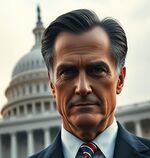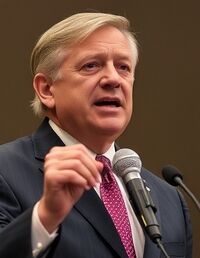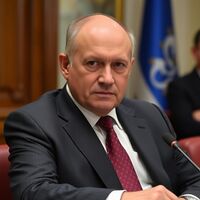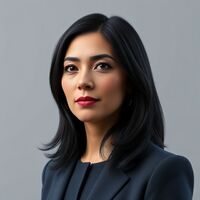Floria presidential election, 1750
| |||||||
270 members of the Electoral College 136 electoral votes needed to win | |||||||
|---|---|---|---|---|---|---|---|
| Opinion polls | |||||||
|
| |||||||
 1750 electoral map, Inclusion of Northcliff Federal District for the first time. | |||||||
| |||||||
Presidential elections are scheduled to be held in the Confederate States around 1750 to elect a president and vice president for a term of 12 years. The victors of the election are expected to be inaugurated in 1751.
Due to provisions set by the constitution, Michael Hutchinson is ineligible for a third term after winning the 1727 and 1738 presidential elections.
As the vice president of the Confederate States, Ronald Trueman Jr. is likely to be considered a frontrunner for the UPR nomination for president, with governor Gerald Tucker of Southland closely behind.
Imogen Walsh, Congresswoman of Southcliff 5th District and Helen Howell, Governor of Kingsland are contenders for the Social Democratic presidential nomination.
Primaries for the presidential candidates will take place in 1744.
Background
As Michael Hutchinson prepares to conclude his second and final term in office in 1750 due to term limits, the political landscape in Floria is shifting dramatically. The United Party of the Republic, despite holding a significant historical presence, is grappling with the aftermath of significant losses in the previous election. These losses have left the UPR at its lowest approval rating in history, facing an uphill battle to secure both the Presidency and Congress in the upcoming election.
Social democracy at the UPR's expense has surged in popularity, particularly among the working class and minority communities, who are advocating for stronger protections of abortion rights and LGBT+ rights, both of which have become central issues in the national conversation. These groups, once politically sidelined, now have a louder voice and are increasingly leaning toward the SDP and its candidates who promise to deliver on these progressive social issues.
Conservatism, once a dominant force, is starting to show signs of fatigue. The traditional conservative values that have long shaped the UPR's platform are no longer resonating with an electorate that is becoming more diverse and progressive. The party's inability to adapt to the changing political climate has contributed to its waning popularity.
With the UPR's future at stake, the party faces a critical crossroads. While the potential still exists for the UPR to secure the presidency and hold onto power in Congress, it will require a major shift in strategy and messaging to capture the support of an electorate that is increasingly favouring social democratic ideals. Whether the UPR can adapt and reconnect with the public or if new, progressive forces will rise to dominate the political landscape remains to be seen.
Electoral system
The president and vice president of the Confederate States are elected through the Electoral College, a group of 270 presidential electors who congregate to vote for the president and vice president. The number of electors in the Electoral College is determined by the total number of senators and representatives with an additional three representatives for Northcliff. Electors cast votes for the president and vice president; the winner is elected through a majority of 136 votes. If the election ends in a tie, a contingent election occurs, in which the House of Representatives votes on the president and the Senate votes on the vice president. The states use a winner-take-all system in which states award all of their electors to the winner of the popular vote.
Presidential candidates are selected in a presidential primary, conducted through primary elections. The results of primary elections, run by state governments, bind convention delegates to candidates.
Article Two of the Confederate States Constitution states that for a person to serve as president, the individual must be a natural-born citizen of the Confederate States and have been a Florian resident for at least 14 years. The Constitution forbids any person from being elected president more than twice. President Hutchinson is ineligible to seek a third term.
Electoral map
Most states in Floria are not highly competitive in presidential elections, often voting consistently for the same party due to longstanding demographic differences. In the Electoral College, this results in major-party candidates primarily focusing their campaigns on swing states, which can swing between parties from election to election. These states are usually located in the east such as Southcliff. These states are critical for a presidential candidate's path to victory. For this election, the swing states are expected to be the Mesounese states, Sri Alba and Southcliff all of which were narrowly won by Hutchinson in 1738. Northcliff Federal District is also expected to be swung either way.
Blue states are states that consistently vote United Republican at the national level. The blue wall has rarely been broken, as these states rarely swing. These states include Southland, South Ontario and Pentucky The last significant breach of the blue wall occurred in the 1707 election.
United Party of the Republic
Candidates
Ronald Trueman Jr.
Ronald Trueman Jr. stands as the natural successor to the Floria First! movement. The 5th Vice President of the nation, Jr. has proven himself a leader with unparalleled experience and powerful resources, making him the frontrunner as the UPR nominee.
However, Ronald Trueman Jr. enters the race with a unique challenge: the controversial legacy of his father’s presidency. Critics worry that Jr. might follow in his father’s footsteps, potentially reintroducing the imperialist policies that defined his predecessor’s term. Despite these concerns, Jr. has firmly denied any intention to adopt such measures, emphasising his commitment to a new era of Floria free from the mistakes of the past committed by the party.
Gerald Tucker
Governor Tucker is the first-ever elected Governor of Southland. After securing his position as Governor, Tucker announced his candidacy for President in 1739, positioning himself as a traditional conservative in the upcoming race. His political platform closely mirrors that of President Hutchinson’s first term, which emphasized stable governance, fiscal responsibility, and strong national defence, in contrast to the more populist policies of Hutchinson's second administration.
As a centre-right candidate for the UPR Primaries, Tucker is advocating for a return to more traditional conservative values, focusing on law and order, reducing government intervention in the economy, and strengthening the nation's position on the global stage.
Tucker's candidacy is seen as an option for those who favour a more moderate and cautious approach, appealing to voters who are wary of the populist surge in recent years and who prefer policies rooted in tradition and established practices. As the centre-right contender in the race, Governor Tucker aims to unite the nation’s conservative factions and offer an alternative vision that prioritises stability and national pride.
Alexander Popov
Popov initially confirmed his bid for the presidency, positioning himself as a serious contender in the race. With a platform focused on strong national defence, economic reform, and maintaining traditional values, Popov sought to rally voters who valued stability and security. His candidacy gained early attention, especially among Nazarene factions, and he was seen as a potential unifying figure for those who felt disconnected from the more populist candidates.
However, in 1741, Popov was forced to withdraw from the race after losing key support from Mesoun government officials, which significantly weakened his campaign. Without the political backing he had relied on, Popov faced an insurmountable decline in momentum and decided to step aside, prioritising his political influence in other ways.
After his withdrawal, Popov made a strategic move by endorsing Ronald Trueman Jr. for president. His endorsement further solidified Trueman Jr.'s position as a frontrunner, particularly among the more nazarene factions of the UPR.
Melissa Mitchell
Mitchell made headlines after her unexpected victory in the Southcliff Gubernatorial election, where she became the first woman and holder of the office. Riding on her surprising success, Mitchell quickly announced her candidacy for President, positioning herself as the only female candidate to enter the presidential race, she garnered significant attention, advocating for centre-right policies.
However, despite the initial excitement surrounding her campaign, Mitchell faced a sharp decline in approval ratings within Southcliff, which significantly impacted her bid for the presidency. Struggling with mounting criticism and political challenges within her state, she ultimately withdrew from the race in 1741. After her exit, Mitchell endorsed Governor Tucker for president.
Stanley Brown
Brown initially confirmed his intentions to run for president, drawing attention as a prominent figure in the House of Representatives and a key leader within his party. With his extensive experience and role as Majority Leader, Brown was seen as a strong contender who could bring stability and leadership to the national stage. His platform was focused on economic growth, and bolstering national security, appealing to voters seeking a steady hand in turbulent times.
However, in 1741, Brown decided to withdraw from the presidential race, opting to continue his work in the House of Representatives. His choice to remain in his position as Majority Leader reflected his commitment to ensuring legislative progress and effective governance, even though it meant stepping away from the presidential contest.
Following his withdrawal, Brown made a significant move by endorsing Ronald Trueman Jr. for president. This endorsement solidified his support for the Floria First! movement and the future leadership of Trueman Jr. Brown's endorsement added considerable weight to Trueman Jr.'s campaign, particularly among more centrist and conservative factions of the UPR.
Social Democratic Party
candidates
| Imogen Walsh | Helen Howell | Jeremy Willis (Withdrew) | John Hamilton (Withdrew) | Justin Nixon (Withdrew) |
|---|---|---|---|---|
| Congresswoman, Southcliff 5th District | Governor of Kingsland | Former secretary of Education | Senior Senator of Victoria | Governor of Victoria |

|
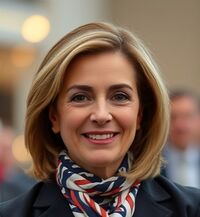
|
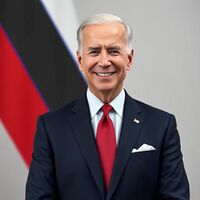
|
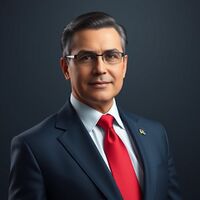
|
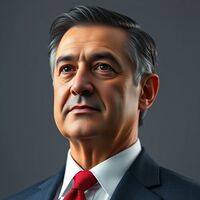
|
Imogen Walsh
Walsh is a prominent left-wing figure and member who, despite a shock loss in the 1739 Gubernatorial elections, announced her bid for the presidency. As one of the leading figures of the SDP's progressive wing, Walsh advocates for a bold reform platform focused on social justice, workers' rights, and environmental sustainability. Her proposals include increased support for trade unions, expanded subsidised public healthcare for all citizens, the introduction of a federal fixed minimum wage, and heavy investment in green resources to combat rising climate change.
In addition to her economic and environmental policies, Walsh is a strong proponent of freedom of movement across Apollonia, believing that greater freedom of movement fosters unity and economic opportunity for Floria. She is also committed to reviving the Department of Education, ensuring greater access to quality education, and supporting the federal legalization of abortion by request, framing it as an essential issue of personal freedom and reproductive rights.
Walsh’s progressive stances have resonated particularly well with the Florian youth, propelling her to the top of the polls early in the race. Her charismatic leadership and unwavering commitment to her principles have made her a popular figure, especially among younger voters who are looking for a more equitable, inclusive, and forward-thinking future. As she heads into the race, Walsh's candidacy is positioned as a transformative option for those who seek to push the country toward greater social and economic reform.
Helen Howell
Helen Howell is running for president with a center-left platform. Known for her ability to unite diverse voices, Howell's campaign is grounded in a commitment to fairness, opportunity, and responsible change. As a seasoned politician with years of experience in public service, she offers a vision that emphasises both economic growth and social justice.
Howell advocates for policies that support working families, such as increasing access to affordable healthcare, strengthening workers' rights, and enhancing education systems across the nation. Her economic plan includes targeted investments in green technologies, ensuring that sustainability is a priority without sacrificing the growth and innovation that drives the economy. With a focus on practical, achievable reforms, Howell aims to create a fairer society while maintaining the country’s economic competitiveness on the global stage.
A key aspect of Howell's platform is her commitment to inclusive policies. She champions the rights of marginalised communities and supports efforts to reduce inequality while maintaining respect for individual freedoms. On the global front, Howell advocates for diplomatic engagement, building strong international alliances, and ensuring the nation is both a leader and a strong partner in regional cooperation.
Jeremy Willis
Jeremy Willis is running for president with a bold, forward-thinking vision that seeks to address the challenges Floria faces while building a better, more inclusive society. His campaign focuses on three central pillars: legalising cannabis, tackling climate change, and reintroducing the Department of Education each designed to move the nation toward a fairer, greener, and more educated future.
Willis believes that the time has come to legalise cannabis nationwide, recognizing its potential to boost the economy through taxation, create jobs, and redirect resources away from punitive criminal policies. His platform emphasizes not only legalising weed but also ensuring equitable access to the industry, especially for communities historically impacted by drug policies. This move, he argues, would lead to a reduction in the criminal justice system's burden while promoting social justice and economic opportunity.
Climate change is another central issue in Willis' campaign. He is committed to ambitious, actionable policies aimed at reducing carbon emissions and transitioning to renewable energy sources. Willis proposes a robust green economy plan that invests in sustainable infrastructure, clean energy, and green jobs. He argues that addressing climate change is not just an environmental imperative but an economic one, offering new opportunities for innovation and workforce development in the green sector.
In addition, Willis is determined to revive the Department of Education, which he believes is crucial to ensuring every child has access to high-quality, affordable education. By reintroducing the department, he aims to create a more unified, national approach to education policy, ensuring resources are allocated to underserved communities and investing in the teachers and schools that shape the future of the nation.
Willis is running for president with a clear mandate: to create a nation that is progressive, forward-looking, and grounded in fairness and opportunity for all.
John Hamilton
John Hamilton, a candidate in the presidential race, entered the contest with a platform focused on strengthening the social safety net, expanding healthcare access, and promoting economic justice. As a proponent of progressive policies, Hamilton advocated for robust climate change action, including a transition to renewable energy and investment in green technologies. He also called for comprehensive immigration reform, increased investments in education, and policies aimed at reducing income inequality.
However, in 1741, Hamilton withdrew from the race due to a combination of declining support and a lack of momentum in key polling regions. Despite his strong platform and dedication to progressive causes, his campaign struggled to gain traction amid a crowded field and shifting political dynamics.
After his withdrawal, Hamilton continued to maintain a presence in the SDP, where he remained an advocate for the issues central to his platform, particularly healthcare reform and social equity. His exit from the presidential race marked the end of his presidential ambitions, but he remained committed to pushing for progressive change in his role as Senator for Victoria.
Justin Nixon
Justin Nixon was a candidate who initially entered the race with a platform focused on social justice, economic equality, and progressive reforms. His campaign sought to address pressing issues such as expanding access to healthcare, improving public education, and promoting environmental sustainability. Nixon advocated for bold policies on climate change, pushing for green energy solutions and stricter environmental protections. He also championed workers' rights, aiming to increase wages and support labour unions.
However, in 1741, after struggling to gain significant traction and facing a loss of momentum in the polls, Nixon withdrew from the race. Despite his early enthusiasm and progressive agenda, his campaign was unable to maintain the necessary support to continue. Ultimately, Nixon chose to step aside from the presidential contest.
Nixon would go on to endorse Walsh.
Third party
Third parties have been a part of Floria's political history since the constitutional reform under Morgan Sharp. However, there is no record of any third party existing in the country after the Democratic Conservative Party disbanded in 1725.
Opinion polling
UPR Primaries
| Date | Polling Organisation | Trueman Jr. | Tucker | Popov | Mitchell | Brown |
|---|---|---|---|---|---|---|
| 1740.5 | FBC | 27% | 23% | 20% | 20% | 10% |
| 1740.6 | Floria Today | 20% | 30% | 20% | 20% | 10% |
| 1741.11 | Floria Today | 70% | 30% |
SDP Primaries
| Date | Polling Organisation | Walsh | Howell | Willis | Hamilton | Nixon |
|---|---|---|---|---|---|---|
| 1740.5 | FBC | 23% | 35% | 22% | 20% | |
| 1740.6 | Floria Today | 31% | 35% | N/A | ||
| 1740.11 | Floria Today | 45% | 30% | 15% |
General election
Trueman Jr. vs. Walsh
| Poll source | Date | Sample size | Trueman Jr. | Walsh | Undecided |
|---|---|---|---|---|---|
| 1740.6 | FBC | 1000 | 43% | 47% | 12% |
| 1740.10 | Floria Today | 1000 | 45% | 50% | 5% |
| 1741.4 | Floria Today | 1000 | 49% | 50% | 1% |
| 1741.7 | FBC | 1000 | 41% | 58% | 1% |
| 1741.9 | FBC | 1000 | 42% | 52% | 6% |
| 1743.5 | Floria Today | 1000 | 45% | 48% | 7% |


